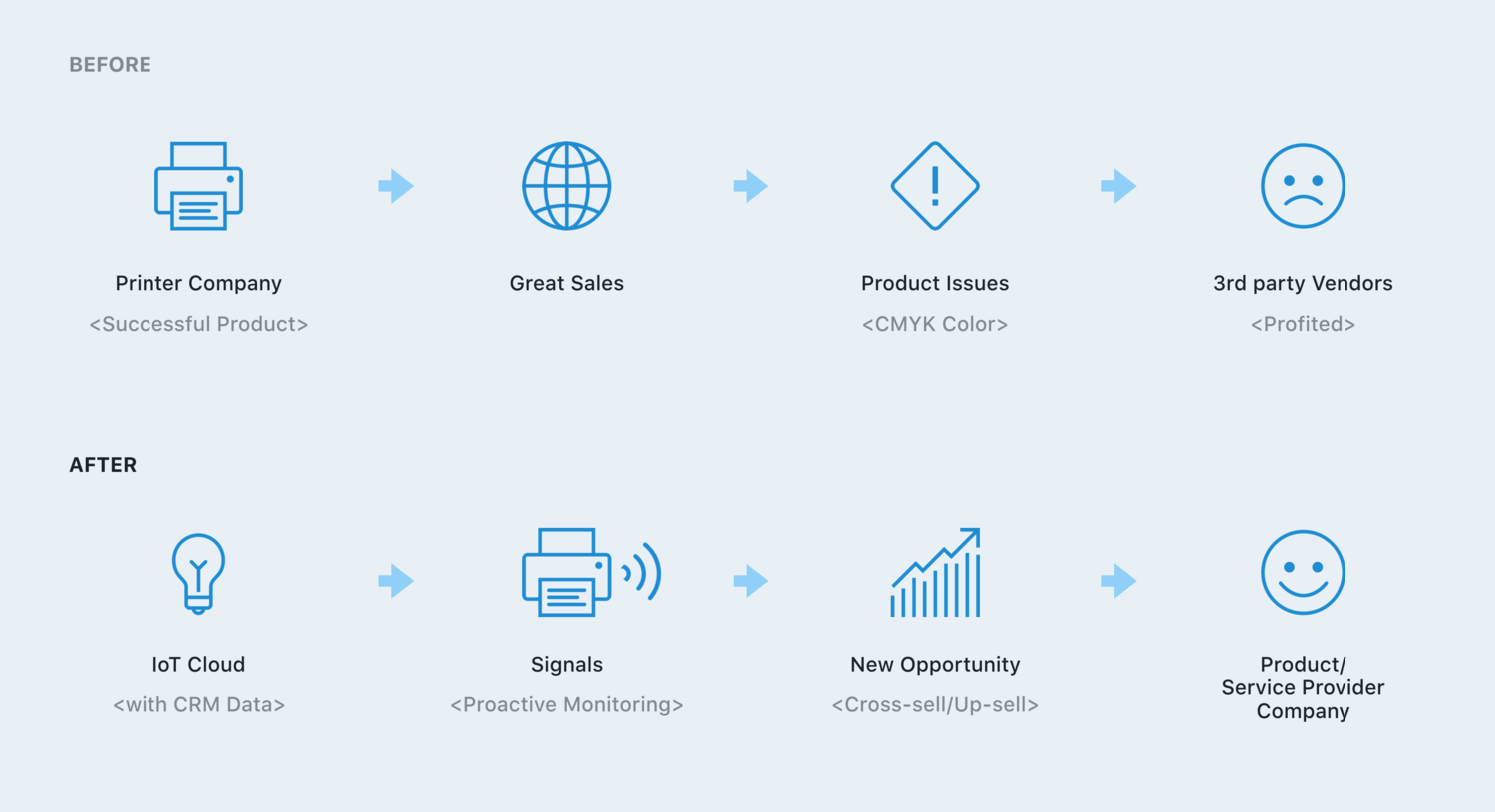Salesforce IoT
Lead Designer | 2015 - 2019
In 2015, Salesforce had announced the IoT Cloud during Dreamforce. The aim was to offer a “low code” experience for the users to generate automated workflows using sensor data. In theory, a non-technical user or a business user could setup sensors, define rules based on different types of connected data and create an automated workflow.
In 4 years, the IoT Cloud transformed from thousands of events to foresee an opportunity to handle millions or even billions of events due to its increasing customer base. Thus, thereby followed various design and usability challenges.
Device, data and customers
For example, let's say you owned a printer manufacturing company and you are doing very well with the printer sales global wide. Let's also assume your company manufactures printer ink too.
Problem
If a customer’s printer is running low on ink, and the cartridge needs to be replaced, they would approach 3rd party vendors like Amazon or BestBuy to purchase ink. This 3rd party purchase creates a potential loss of sale for the printer company.
Solution
Since every printer emits signals error codes (such as ‘Low on ink’), an IoT event cloud could be set up to monitor those signals proactively and trigger an action based on a predefined workflow. For the above example, the moment the printer emits an ‘Low on ink’ signal, IoT Cloud could trigger a marketing email to the customer to choose the best deal for the cartridge.
It's just not about creating new business opportunities by combining the sensor data with the CRM data, but it is also about proactive monitoring. How excellent is a service when there is no need for a customer to call up and complain, rather than to be able to predict the state of the device and advise in advance? Isn't that the dream!
Connect, build & deploy. Voila, you’re done!
The IoT Cloud product is divided into the following five steps.
1. Connect Devices: The devices here are referred to the data signals emitting devices such as thermostats, wind turbines, etc. are connected through the HTTP requests.
2. Massage Signals: The data is usually a JSON code and hence, you would want to take the meaning full attributes/data so that to perform business logic in the next steps which could be done by code or by point and click approach.
3. Join signals to CRM data: Now that you have filtered the right type of data from the incoming signals, at this step you would combine the CRM data, i.e., the contextual data about your customer ( for example, customer records in Salesforce, etc.)
4. Write conditional logic: IoT cloud uses states machine approach instead of a linear workflow process. Hence, it consists of states and transitions. The rules are defined in every state. The rules are generally the business logic conditions such as “If this, then that” and in this context, the rule-writing experience is called as “orchestrations.”
5. Take action: The outputs are the actions that are resulted based on the triggered signals or events in an orchestration. The outputs could range from sending an email, text message to opening up a service case in the service cloud of salesforce.
My brief design process with a Usage data and Statistics case study at Salesforce. Please reach out for detailed case studies.
The Design Process
Complete Experience
Product Design - IoT
Part of a 2-person User Experience Design team responsible for the Salesforce IoT product over Web and Mobile
Ideation and interaction design for IoT team in the incubator and responsible for the initial design and direction of the Salesforce IoT product. Worked closely with research and product to try to solve the IoT problem in the Sales and Marketing industry. Some of the larger case studies include:
Salesforce Design Crits
Fostered and evangelized design crit culture in Salesforce by creating a V1 of the Design crit methodology.
- In depth analysis of design crits created a methodology that best fits the Salesforce ecosystem.
- Designed a story on how to get the change started in design teams at Salesforce by creating tools, rules and norms around the problem.
- Set standards and tools in place that designers can quickly use to start a crit going.
- Presented and evangelized the problem in the form of a story at a company wide all-hands.
Result: Positively received, as a lot of designers felt the need for this. As of today,
all the design teams in Salesforce have a design crit once a week, and the crits are available to
view and attend on the internal Design Crit calendar.
IoT Cloud User Experience
Brainstormed, sketched and designed the IoT Cloud product from inception with 3 more designers.
- Responsible for the ideation, design and execution of one of the most complicated Enterprise
IoT systems, which in general is handled by 5 users, to be handled by 1 user (Persona name: Composer).
- Spent over 120 hours in research, validating designs and concepts to make the Salesforce IoT
Cloud product what it is today.
IoT System view – IoT Cloud
Debugging & Logging Experience – IoT Cloud
Designed and developed the IoT Cloud’s activity logging system.
Usage Data and Statistics – IoT Cloud
Lead the project in designing IoT Cloud’s Usage data and monitoring experience.


